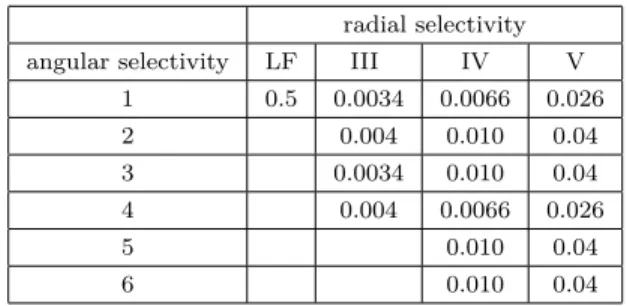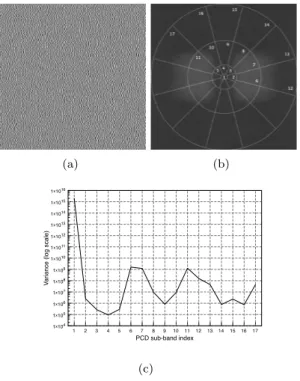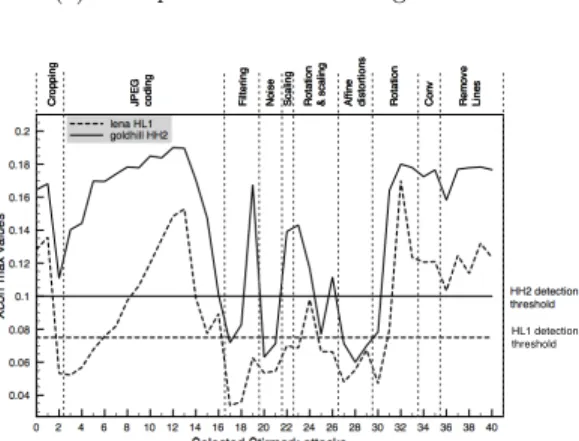HAL Id: hal-00267649
https://hal.archives-ouvertes.fr/hal-00267649
Submitted on 12 Jul 2010
HAL is a multi-disciplinary open access
archive for the deposit and dissemination of
sci-entific research documents, whether they are
pub-lished or not. The documents may come from
teaching and research institutions in France or
abroad, or from public or private research centers.
L’archive ouverte pluridisciplinaire HAL, est
destinée au dépôt et à la diffusion de documents
scientifiques de niveau recherche, publiés ou non,
émanant des établissements d’enseignement et de
recherche français ou étrangers, des laboratoires
publics ou privés.
JND Mask Adaptation for Wavelet Domain
Watermarking
Mohamed Bouchakour, Guillaume Jeannic, Florent Autrusseau
To cite this version:
Mohamed Bouchakour, Guillaume Jeannic, Florent Autrusseau. JND Mask Adaptation for Wavelet
Domain Watermarking. Intl. Conf. on Multimedia and Expo (ICME), Jun 2008, Germany. paper
1163. �hal-00267649�
Cover Page
1) Title of the paper:
JND MASK ADAPTATION FOR WAVELET DOMAIN
WATERMARKING
2) authors’ affiliation and address:
IRCCyN-IVC, (UMR CNRS 6597), Polytech' Nantes
Rue Christian Pauc, La Chantrerie, 44306 NANTES, France.
Tel : 02.40.68.32.47
Fax : 02.40.68.30.66
3) contact author:
Florent.Autrusseau@polytech.univ-nantes.fr
4) Conference & Publisher information:
IEEE ICME 2008
http://www.icme2008.org/
http://www.ieee.org/
5) bibtex entry:
@inproceedings{Bouchakour08,
Address = {Hannover},
Author = {M. Bouchakour, G. Jeannic, F. Autrusseau},
Booktitle = {IEEE International Conference on Multimedia and Expo},
Month = {June 23-26},
Title = {JND Mask Adaptation for Wavelet Domain Watermarking},
Year = {2008}}
JND MASK ADAPTATION FOR WAVELET DOMAIN WATERMARKING
Mohamed Bouchakour, Guillaume Jeannic, Florent Autrusseau
Polytech’Nantes, IRCCyN lab, rue Christian Pauc,
La Chantrerie, BP 50609, 44306 Nantes, FRANCE
ABSTRACT
One of the most challenging issues for watermarkers is to tune the strength of their watermark embedding. The strength is usually an α parameter which is increased un-til a reasonable trade-off between invisibility and robust-ness is achieved. The watermarking community needs efficient Just Noticeable Difference (JND) masks to op-timally embed the watermarks. The Fourier transform is particularly adapted to the Human Visual System (HVS) modeling. In this work, we evaluate the usability of the JND mask in the wavelet domain. The use of the mask in the DWT domain involves some approximations. We will see here that the HVS decomposition and the wavelet decomposition do not perfectly fit altogether. The effi-ciency of the so obtained mask is tested both in terms of invisibility and robustness.
1. INTRODUCTION
It is widely admitted that among the different require-ments needed in watermarking applications, the ro-bustness and invisibility are very important. The wa-termark’s robustness is inversely proportional to the
invisibility. Thus, in watermarking context,
optimis-ing the invisibility versus robustness trade-off is crucial. Perceptual modeling is very important in watermarking context, it is in fact crucial to embed the watermark in the perceptually significant image areas, otherwise, the watermark wouldn’t resist to lossy compression. Of course, as many studies have been conducted on the design of perceptual models for image compression tech-niques, several DCT or DWT based perceptual masks can be found in the watermarking literature [6, 7]. How-ever, most of the DCT perceptual masks are simply based on quantization matrices, and do not take into account more complex processes, such as masking effect. One of the most advanced DCT/DWT perceptual wa-termarking technique was proposed by Podilchuk and Zeng [1]. The authors designed an image adaptive wa-termarking algorithm exploiting Watson’s works for the perceptual masks implementation. Bartolini et al. have
This work is partially supported by the ANR-Safimage project
studied several perceptual masks in [4]. The first one exploited a complex multiple channels HVS model, the second was based on the local variance computation, and the last one was made from heuristic considerations. They used a bank of filters to extract an appropriate frequency range, and a Sobel filtering detecting the im-age edges. The authors claimed that the masks based on heuristic consideration presented better detection re-sults than HVS based masks. The watermark weighting has always been a very challenging problem. Authors in [5] introduce the Noise Visibility Function (NVF), a content adaptive watermarking embedding scheme was designed for noise-like watermarking embedding. However very few complex HVS models are used for wa-termarking purpose. Evidently, an important drawback of HVS models lie in their complexity. Providing to the watermarking community an efficient (HVS based) low complexity JND mask remains an open challenge.
The goal of this paper is to adapt a previously de-signed JND mask in the wavelet domain. Effectively, we recently proposed in [2] a JND mask based on quanti-zation noise visibility thresholds, and an adaptation of the mask in a Fourier domain embedding technique. As we will see in section 2 there are some incompatibilities between the Fourier splitting of the human visual sys-tem model and the Fourier representation of the wavelet sub-bands. However, as explained later, the quantiza-tion thresholds being quite similar for neighboring visual sub-bands, in this work, we spread the watermark in one DWT sub-band, and verify that most of the Fourier rep-resentation of the watermark is included within at most two neighbouring visual bands. We hereby adapt the previous embedding technique operating in the Fourier domain into the wavelets. We evaluate the efficiency of the mask regarding both invisibility and robustness. The Stirmark benchmark is used to evaluate the robustness of the proposed algorithm and PSNR, wPSNR and C4 are used to assess the quality of the marked images.
This paper is structured as follows: Section 2 presents the HVS model that we use as well as the JND mask and its adaptation to Wavelets. In section 3 we present the adaptation into wavelets and the embedding technique. Finally, section 4 gives experimental results for both
in-visibility and robustness.
2. HUMAN VISUAL SYSTEM MODEL
Based on psychophysics experiments conducted in our lab, we have derived a Perceptual Channel Decomposi-tion (PCD). The filters of the PCD are similar to the cortex filters developed by Watson. Interested reader may refer to [2] for further details on the HVS model and JND masks. As pointed out in [3], there are some incom-patibilities between the HVS models decompositions and Wavelet sub-bands. Effectively, in the Fourier spectrum,
sub-bands at 30◦ and 150◦ are treated separately along
the visual pathways, and processed by different cells in the visual cortex, whereas, in the DWT domain this in-formation is grouped into the same HH sub-band. As a consequence, for example, modeling the self-masking effect in these sub-bands is limited. One coefficient in the transform domain might represent different signals
at 30◦ and 150◦ which do not mask each other. The
PCD, defined in cycle/degree, in the frequency domain is given Figure 1-a. Figure 1-b shows a superimposition of the wavelet tilling of the spectrum on the PCD. The wavelet frequency decomposition being defined regarding the sampling frequency, this superimposition only makes sense assuming that the image is viewed under certain viewing conditions. The local contrast for a given (m, n)
I V.1 I V.2 I V.3 I V.4 I V.5 I V.6 V.1 V.2 V.3 V.4 V.5 V.6 III.1 III.2 III.4 III.3 28.2 1.5 5.7 14.2 cycle/degree cy cl e/deg ree
(a) Perceptual Channel Decom-position 28.2 cycle/degree cy cl e/deg ree 14.1 7 3.5 HH0 HL0 LH0 LH1 HH1 LH1
(b) Fourier splitting of the wavelet sub-bands
Fig. 1. Superimposition of perceptual channel decom-position and wavelet tiling of the spectrum.
pixel location in the ithcrown and the jthangular
chan-nel is defined as the ratio between the luminance of the reconstructed (i, j) sub-band at the specified pixel lo-cation and the mean luminance of all the below radial sub-bands. This gives the equation 1
Ci,j(m, n) =
Li,j(m, n)
Li(m, n)
, (1)
where i represents the ith radial channel and L
i(m, n)
is the local mean luminance at the (m, n) position (i.e.
spatial representation of all Fourier frequencies below the considered visual sub-band). We use the local con-trast definition to determine the allowable watermark strength. Previous studies, conducted on the percep-tual decomposition 1-a, determined invisible quantiza-tion condiquantiza-tions. Each perceptual sub-band was indepen-dently quantized and the image quality was assessed by a set of observers. The optimal quantization step (∆C), which does not visually affect the image, has been
in-troduced. The formula for computing the ∆Ci,j values
can be found in [2], and Table 1 below gives the values provided by observers during subjective experiments.
radial selectivity angular selectivity LF III IV V
1 0.5 0.0034 0.0066 0.026 2 0.004 0.010 0.04 3 0.0034 0.010 0.04 4 0.004 0.0066 0.026 5 0.010 0.04 6 0.010 0.04
Table 1. Experimental ∆Ci,j for every PCD sub-band.
3. PERCEPTUAL WATERMARKING
As previously explained, we can define the visibility of quantization noise in visual channel content for com-plex signals. We will now exploit this property in a watermarking context for the strength determination process. Since this model operates in a psychovisual space, the input image has to be converted into
lu-minances (in Cd/m2) depending on the display. The
monitor’s "gamma function" is used to transform the digital grey level values N (m, n) into the photometric
quantity known as luminance: L(m, n) = Lmin+ Lmax×
!
N(m,n) 255
"γ
where Lmin= 0.7, Lmax= 69.3 Cd/m2and
γ = 1.8. The proposed masking model suggests that
we can control the visibility at each spatial site of the sub-band. So the most adequate sites of the image can be easily defined by extracting one (or several) spectrum sub-band(s). This selection may be content based, i.e.
select the sub-bands of largest energy. Derived from
eq. 1, the maximum watermark strength ∆Li,j(m, n)
al-lowable for each (i, j) sub-band at (m, n) pixel position, which do not induce visible artifacts is given by
∆Li,j(m, n) = ∆Ci,j× Li(m, n) . (2)
∆Li,j(m, n) represent the JND mask computed for
each (i, j) sub-band. Finally a perceptual weighting
domain representation and the visual mask(eq. 3): Ki,j= argminm,n !# # # # ∆Li,j(m, n) WS(m, n) # # # # " , (3)
where WS(m, n) is the watermark’s spatial
representa-tion before weighting process by factor Ki,j for each
(m, n) spatial position. It is very important to notice that the JND masks proposed by this technique are
suit-able for specific frequency contents i.e. for a chosen
sub-band, the frequency content of the embedded wa-termark should ideally be totally restrained in the same frequency content. Actually, the frequency representa-tion of the watermark should be fully included within a PCD sub-band, whereas the corresponding JND mask is entirely made of the lower frequency disk. Restraining the watermark within a PCD sub-band is indeed easy in the Fourier domain [2], however, as previously em-phasized, the wavelets sub-bands do not overlap entirely in the PCD sub-bands (Figure 1). One solution to best match the PCD, would be to embed only in the inter-section of both sub-bands. A watermarking technique was designed in the DWT domain, in order to confirm the mask’s efficiency to others embedding domains. A three stages wavelet transform (9/7 filters) was applied on the input image, a noise-like watermark was
embed-ded independently in the HH2 or LH1. The detection
technique remains the same as the one previously pre-sented in [2]: cross-correlation is computed between the stored watermark and the extracted DWT coefficients.
4. EXPERIMENTAL RESULTS
Figure 2-a shows the spatial representation of the weighted watermark along with its Fourier representa-tion (2-b), where the PCD is superimposed to explicitly show that most of the watermark’s energy is contained within the appropriate visual sub-bands. It is important to notice on Figure 2-a that the proposed JND mask do not allow a strength adaptation in high activity areas, the watermark’s strength is not increased in the image edges or textures. The JND mask being composed of weighted low frequencies (eq. 2) it provides a global watermark weighting parameter. Figure 2-c shows the variance of the watermark for each PCD sub-band (com-puted in the Fourier domain). This plot confirms that the frequency representation of the DWT watermark is indeed maintained in the visual sub-bands (peaks at positions 6, 7 and 11, see sub-bands numbering in Fig-ure 2-a), and thus, the ∆C value of sub-band (IV, 1) can be used here for the mask implementation. As previously explained in section 3, the normalized cross-correlation is computed between the wavelet sub-band of the marked image, and the wavelet representation of the weighted
(a) (b) 1 2 3 4 5 6 7 8 9 10 1112 131415 1617 PCD sub-band index 1x104 1x105 1x106 1x107 1x108 1x109 1x1010 1x1011 1x1012 1x1013 1x1014 1x1015 1x1016 V a ri a n ce (l o g sca le ) (c)
Fig. 2. (a) Spatial representation of a HL1 watermark
along with (b) its Fourier representation and (c) variance within each of the 17 PCD sub-bands.
watermark. Stirmark attacks were used to assess the ro-bustness of the DWT embedding technique. Figure 3-b represents the cross correlation max value (Y-axis) as a function of 40 selected Stirmark attacks (X-axis). Unlike the Fourier domain embedding technique [2], the water-mark is more widely spread into the frequency domain,
and thus, the weighting parameter (Ki,jin eq. 3) is
sen-sibly lower and so are the correlation peaks (Y-axis in Figure 3-b). However, false positive and false negatives have been computed and the optimal detection threshold is set to 0.075 (dashed vertical line in Figure 3-a). The detection rate was found to be 60% for watermarks in
sub-band HL1 (dashed lines) and 80% for watermarks
in HH2 (solid lines). Effectively, as less coefficients are
marked in HH2, the strength is increased, and so is the
robustness. The main goal of this work is not to propose a full DWT domain watermarking technique, but rather to adapt a spatial JND based on complex HVS prop-erties into the wavelet domain and ensure the usability of the mask. Table 2 summarizes the quality assess-ment of the proposed embedding technique compared to previous works operating in the Fourier domain [2]. PSNR, wPSNR, SSIM and C4 were used (refer to [8] for details and performances of the quality metrics). We can notice on Table 2 that the quality requirements are
fulfilled, all metrics present very good results. Most
0 0.1 0.2 0.3 0.4 0.5 0.6 0.7 0.8 0.9 Detection threshold 0 20 40 60 80 100 D e te ct io n ra te (% ) False positives False negatives
(a) False positives and False negatives rates.
0 2 4 6 8 1012 14 1618 2022 2426 28 3032 3436 3840
Selected Stirmark attacks
0.04 0.06 0.08 0.1 0.12 0.14 0.16 0.18 0.2 Xco rr ma x va lu e s lena HL1 goldhill HH2 C ro p p ing JPEG cod in g F ilt e ri n g N o ise Sca lin g R o ta ti o n & s c a lin g A ffi n e d ist o rt io n s R o ta ti o n C o n v R e mo ve L in e s HL1 detection threshold
(b) Cross-correlation peaks for 40 attacks.
Fig. 3. Detection performances.
in [2], where subjective experiments were used to val-idate the objective scores. This slight improvement in objective quality measures is due to a wider spreading of the watermark in the Fourier frequencies. However, the wider is the watermark, the lower might be its strength. Thus the robustness performances in the DWT domain might be slightly lower than in [2]. For SSIM and C4, the closer the measure is to one, the best is the quality.
Table 2 shows results for watermarked image in the HL1
and HH2 sub-bands. For comparison purpose, the
bot-tom value gives results for the watermarking technique operating in the Fourier domain (8 × 8 watermark in sub-band (IV, 1)).
5. CONCLUSION
Although invisibility is a strong requirements for digital image watermarking, very few JND masks take into ac-count advanced HVS features. Several perceptual masks based on heuristic considerations are proposed, but in order to make the embedding possible in the whole in-put image, including the smooth areas, complex HVS models must be considered. We proposed here an adap-tation of a spatially defined JND mask into the wavelet domain. The proposed mask model have been evaluated in terms of both invisibility and robustness capabilities and showed good results regarding both requirements.
Image PSNR SSIM wPSNR C4 HL1 49.3 0.991 50.7 0.978 lena HH2 52.8 0.996 54.1 0.974 from [2] 48.7 0.964 49.9 0.974 HL1 53.2 0.996 54.9 0.949 boats HH2 52.8 0.995 54.5 0.951 from [2] 45.2 0.980 46.9 0.985 HL1 51.2 0.997 53.2 0.946 goldhill HH2 52.7 0.998 54.6 0.931 from [2] 47.0 0.993 48.7 0.974 HL1 53.2 0.996 54.9 0.986 baboon HH2 52.8 0.999 57.7 0.977 from [2] 42.8 0.992 47.5 0.978 HL1 53.1 0.996 54.3 0.910 kodie HH2 52.8 0.996 54.1 0.904 from [2] 51.8 0.987 53.4 0.980
Table 2. Quality assessment within two distinct levels.
6. REFERENCES
[1] C. I. Podilchuk, W. Zeng, Image-adaptive water-marking using visual models, IEEE J. S. A. C., 16 (4), (1998) 525-539.
[2] F. Autrusseau and P. Le Callet, A robust image watermarking technique based on quantization noise visibility thresholds, Signal Processing, 87(6), 2007, 1363-1383.
[3] W. Zeng, S. Daly, S. Lei, An overview of the visual optimization tools in JPEG 2000, Signal Processing: Image Communication 17 (2002) 85–104.
[4] F. Bartolini, M. Barni, V. Cappellini, A. Piva, Mask building for perceptual hiding frequency embedded watermarks. Pro. of the ICIP’98, 450-454, 1998. [5] S. Voloshynovskiy, A. Herrigel, N. Baumgaertner, T.
Pun, A Stochastic approach to content adaptive digi-tal image watermarking, Intl. Workshop on Info Hid-ing, LNCS 1768, 212-236, 1999.
[6] X. Huang and B. Zhang, "Perceptual Watermarking Using a Wavelet Visible Difference Predictor", Proc. of IEEE ICASSP, 2005.
[7] T. Chih-Wei and H. Hsueh-Ming, "Exploring effec-tive coefficients in transform-domain perceptual wa-termarking", SPIE Electronic Imaging, Security and Watermarking of Multimedia Contents, 95-106, 2003. [8] E. Marini, F. Autrusseau, P. Le Callet, P. Camp-isi, Evaluation of standard watermarking techniques, SPIE Electronic Imaging, Security, and Watermark-ing of Multimedia Contents, 2007.


